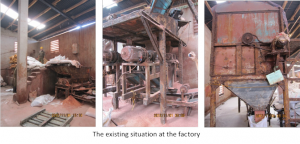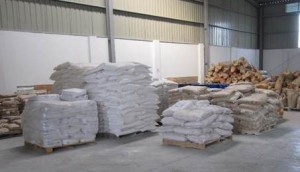The project has achieved impressive results that can be summarized, as follows:
- Country needs assessment report: This report was prepared to provide the basis for the development of thecountry programme on promoting resource efficiency in SMEs and identify the focus for the training andtechnical back-up support to be provided by the project “Promoting Resource Efficiency in SMEs in Viet Nam. The report includes eight chapters as follows:
- Chapter 1: Introduction- introduces the need assessment
- Chapter 2: Background – presents objectives, methodology of the need assessment
- Chapter 3: Economic and industrial context of the country where the industrial picture of Vietnam is shown under ownership structure, geographical distribution, and pollution status aspects. At the same time, theindustrial development strategy is reviewed and the situation in health and safety practices in industries isanalysed.
- Chapter 4: Environmental legislative and institutional framework and supporting schemes/programs. This chapter introduces the main legal documents and industrial framework in environmental management relatedto resource consumption and pollution control. It also presents some schemes/programs supporting CP/resource efficiency or energy conservation in Vietnam.
- Chapter 5: Overview of Small and Medium Enterprises, as well as SME development strategy, are compiled in this chapter. Resource efficient practice in SMEs is analysed and the framework for resource management in Vietnam in terms of resource management and resource pricing is reviewed.
- Chapter 6 Sectoral analysis – provides more in-depth information on the potential sectors in terms of economic and environmental importance as well as potential in resource efficiency of selected sectors: pulp and paper, textile, food processing, plastic.
- Chapter 7: Findings and Recommendations – provides findings on status of supporting resource efficiency approach and of SMEs, proposes measures to promote resource efficiency in small and medium enterprises at short term and long term levels.
- Chapter 8: Conclusion- highlights the key concluding points of the needs assessment
The country needs assessment report shall be a reference source for other projects as well as for researchers, policymakers, technical institutions, business and industry associations and interested companies.
- Regional workshop on Promoting Resource Efficiency in Small and Medium Sized Enterprises: This workshop gathered 24 experts from Vietnam, Thailand, Sri Lanka, Indonesia and India. The workshop was held from 13-16th of October, 2009 with three main objectives:
- To impart regional RECP experts/service providers with substantive and pedagogical knowledge and skills on promoting resource efficiency in SMEs (on the basis of the approach proposed in the draft toolkit);
- To validate the responsiveness and user-friendliness of the draft toolkit to users in developing countries. These users include RECP experts and SMEs (more specifically SME directors and production managers);
- To solicit input from the RECP service providers from the region for further development of the draft toolkit, training methodology and training manual.
At this workshop, a first draft version of the toolkit was presented and introduced to invited RE CP experts and created a very good impression and interest.
- SME training workshop: 12 companies from various industrial sectors (pulp and paper, dyeing, cement, plastic processing, seafood processing, metal finishing, sugar cane, granite tile flooring) were selected to participate in the pilot program. Two participants from each company were invited to the training workshop (including a management representative and a technical staff person). These participants played a key role in implementing project related activities in the companies. The workshop took place from 16-20th of November, 2009 in Hanoi. At this workshop, a new revised version of the draft toolkit was introduced and tested by participants from invited SMEs. RECP experts who had been trained at the previously held Regional workshop assisted other participants in using the toolkit. The following are the objectives of the SME training workshop that were successfully achieved:
- To disseminate the concept of RE, its approach and options to save resources and improve efficiency in the following thematic areas: water, energy, chemical, materials and waste;
- To introduce enterprises to RE concepts and tools by applying the RE toolkit, emphasizing potential benefits to be obtained from more efficient production processes, such as reduced costs, increased profits, and higher competitiveness;
- To share the experiences and lessons learned from the actual implementation of RE among SMEs;
- To obtain advice from national experts on how to address the actual situations that SMEs are facing; and
- To build up the detailed work plan for implementing the next steps of the project.
- RECP assessment at 12 selected enterprises: 12 companies from various industrial sectors were divided to 2 groups: (1) companies that had previously applied CP assessments and (2) companies that had not applied CP assessments yet. Companies taking part in the pilot industrial exercise had approximately five months to carry out RECP assessments with direct support from RECP experts coordinated by the VNCPC. The companies belonging to the first group had a longer time in applying RECP assessments. Some of them had received financial support from others project allowing for the implementation RECP options with high investment costs.
The RECP assessment phase and the implementation of some of the selected improvement options were initiated right after the conclusion of the SME training workshop. Key focal persons in each company met together with RECP experts for 3 working sessions on site as shown in the figure below:
Enterprises followed several steps whilst carrying out the RECP assessments with some modifications to better fit their own existing situation:
- Steps for team building and gaining management commitment: Building of RECP teams included production group leaders, technicians, production managers and factory manager. All members were introduced to the benefits of the programme and implementation via the toolkit.
- Measuring, defining, collecting and analysing data: Data was collected from accounting notebooks, statistics, and interviews with technicians, checking parameters on the machines, checking measurement equipment, and using handheld equipment for quick measurement.
- Integrating current systems and management program: In companies with international management standards (ISO 9000, HACCP), this program was integrated with the management program.
- Support and commitment of top management: The management board committed to apply RECP methodology. Management representatives participated in the RECP workshops and engaged in the activities that led to the implementation of the RECP assessments.
- Encouraging the involvement of labour force: Production group leaders and technicians took part in the program.
In general, 12 companies have implemented 279 RECP options out of 323 proposed options (approximately 86% of RECP options have been implemented). The RECP options have been categorized into 6 groups: (1) Organizational options covering factors that have direct bearing in the efficiency of the factory including factors such as production planning, working procedures, and training of personnel; (2) Product specifications and design optionscovering aspects related to changing the specification and/or design of a product in order to have a better yield with the same or improved functionality; (3) Materials acquisition and management options covering possible changes that could be made on material selection procurement and handling of inputs that are required for the production process; (4) Process control and modifications including specific improvements that could be made in controlling the relevant process parameters and the related modifications that could be made to improve the efficiency of the industry; (5) Technology substitution containing the specific areas where there is a need to invest on acquisition of new technologies in order to address significant bottlenecks for moving towards a higher resource efficiency level; (6) Safer production and accident prevention including specific areas and practices where actions need to be taken in order to promote safer production and prevent or reduce the potential for industrial accidents.
Total investment of all 12 enterprises as updated in April 2010 was approximately 7,630 million VND (400,000USD) and saved an estimated 5,160 million VND per year (271,000USD/year). In particular, Dong Nam Paper., JSC invested only 30 million VND (1,600USD) to repair the insulation layer of a steam system and isolate edges of rollers, and saved 200 million VND (10,500USD/year) by saving cashew nut shells. Nguyen Tan Trading and Production Private Enterprise invested 7 million VND (370USD) to cover the insulation for heated cores and saved 103 million VND per year (5,400USD/year) by saving on electricity consumption. Other benefits from implementing RECP included saving more than 4,000,000 m3 of water per year, reduced electricity consumption by 43 million kWh per year, saving more than 350 tons of coal per year and more than 5,614 tons of raw materials consumption of all types.
- Experience exchange workshop: this workshop was held on 24th of March, 2010 in Hanoi between the second and third expert support missions of RECP assessment at enterprises. In this workshop, management representatives as well as staff from companies taking part in the pilot industry exercise shared their experiences and lessons learnt during the application of RECP methodologies and the toolkit at their companies.
- PRE-SME National web portal : Project description, outcomes and achievements at country level have been consolidated into a specific portal which is hosted Vietnam National Cleaner Production Centre’s website:http://www.vncpc.org
 With the characteristics of fertilizer production in which Ammonium-contained materials are used at huge amount and producing within an open environment (materials processing on rotary trays, open conveyers, etc.), the NH3 generated from decomposing of those materials becomes the most dangerous threat for workers, equipment and even material loss.
With the characteristics of fertilizer production in which Ammonium-contained materials are used at huge amount and producing within an open environment (materials processing on rotary trays, open conveyers, etc.), the NH3 generated from decomposing of those materials becomes the most dangerous threat for workers, equipment and even material loss.
 Thanks to the application of RP approach and methodology, and RP tools, the company was able to build the inventory for using chemicals, raise awareness in chemical management, and implement some proposed RP and RP-related options. The project will be continued at the Factory No.3 and will be replicated at other ones, especially at the under-construction one.
Thanks to the application of RP approach and methodology, and RP tools, the company was able to build the inventory for using chemicals, raise awareness in chemical management, and implement some proposed RP and RP-related options. The project will be continued at the Factory No.3 and will be replicated at other ones, especially at the under-construction one.



